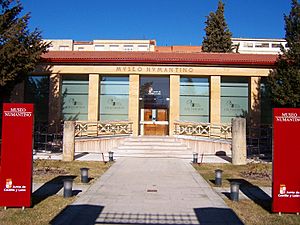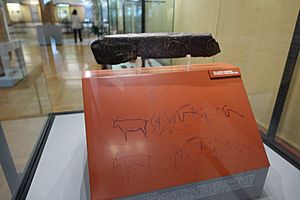Numantine Museum of Soria facts for kids
| Museo Numantino de Soria | |
 |
|
| Established | 1919 |
|---|---|
| Location | Soria, Spain |
| Visitors | 330.030 (2009) |
The Numantine Museum of Soria is a cool place in Soria, Spain. It helps us learn about the very old history of the province of Soria. The museum shows us amazing art and objects found by archaeologists. Its name, "Numantine," comes from Numantia, a famous ancient hill fort just a few kilometers away.
This museum is like the main hub for other smaller museums in the area. For example, it connects with the Museo Paleontológico de Ambrona. The museum has many items from Numantia. It also shows things from other ancient towns like Tiermes and Uxama. These items help us understand what life was like in the Iron Age.
Contents
Museum History
The Numantine Museum of Soria started in 1919. It was created by joining two older museums in Soria. One was the Provincial Museum, which opened in 1913. The other was the Museo Numantino. This second museum grew from studying the ancient site of Numantia. People started studying Numantia in the 1800s. The studies became very important between 1906 and 1923.
The museum building was designed by Manuel Aníbal Álvarez. Ramón Benito Aceña helped pay for it. The local council gave the land for free. King Alfonso XIII officially opened the museum on September 18, 1919.
Over the years, the museums changed names and joined together fully. In 1941, the two museums united. They became one big museum in 1968. The museum was fully updated in 1989. This made its exhibition space much larger, about 7,000 square meters.
Exploring the Building
The original museum building had one floor and three sections. These sections divided two courtyards. The sections are still there today. But in the 1980s, the main part of the building grew to three floors.
When you visit, you follow a path through time. It starts with the Lower Paleolithic period, which is very, very old.
What You Can See
- Bronze Age: You can see old weapons and tombstones.
- Iron Age: There are cool ceramic pots from ancient hill forts called castros.
- Celtiberian Period: This part has pottery, brooches, and tools. Many of these items come from Numantia, Uxama, and Tiermes.
- Roman Period: You'll find objects from Roman villages and cemeteries.
- Middle Ages: The tour ends with items from the Middle Ages. These include old building parts, pottery, and coins.
Easy Access for Everyone
The museum is designed so that blind and partially sighted people can enjoy it too. Many items and copies are available for visitors to touch. This helps them experience the exhibits in a different way.
Amazing Collections
The museum has many incredible collections from different time periods.
Stone Age Discoveries
There are not many human remains from the Stone Age in Soria. But the museum has amazing bones from a huge ancient elephant. This elephant, called Palaeoloxodon antiquus, lived about 400,000 years ago. These bones were found at the Torralba and Ambrona sites. Here, ancient people butchered these large animals.
You can also see a special piece called the Placa de Villalba. It's a slate plaque found in the 1980s. It shows animals from the Stone Age. The museum also has many objects from the Neolithic period. These were found in the southwest part of the province.
Copper and Bronze Ages
The museum also displays items from the Bell Beaker culture. This culture existed during the Chalcolithic (Copper Age) and the Bronze Age. You can see pieces from the Covelda site and the Villar del Alba menhir.
Iron Age Treasures
The Iron Age collection is very rich. It includes finds from Numantia, Tiermes, and Uxama. This period fills the upper floors of the museum. It's called the Celtiberian Section. This section is also organized by time. It shows early, middle, and late Iron Age items.
You can see a special funerary stone with swords. There are also brooches, chest plates, and spiral plates. Many funerary urns are on display too. The collection of ancient pottery is especially important.
Roman and Later Periods
The Roman period brought big changes to the area. The museum shows items from Roman sites like Cuevas de Soria and Santervás del Burgo. There's a special focus on things found at Numantia.
There is also a collection from the Visigothic period. These items come from places that became towns like Numancia, Osma, and Tiermes.
The museum also has important Muslim artifacts. These show the strong Muslim presence in the province. They even had their capital in Medinaceli. After the Muslims left, Christian people moved in. They brought Romanesque and Gothic art with them.
See also
 In Spanish: Museo Numantino de Soria para niños
In Spanish: Museo Numantino de Soria para niños


